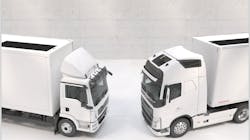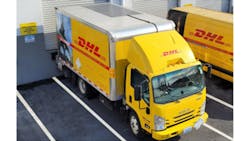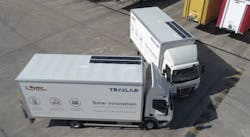If there’s anything that the last few years have taught fleets, it’s that lowering the operational costs for fleet owners will not happen soon, nor by itself. Yet in a conference sponsored by The American Transportation Research Institute (ATRI), fuel cost was listed as the most critical issue the industry faces.
In a panel discussion, Dennis Dellinger, president and CEO of Cargo Transporters, echoed this sentiment.
Read more: Prolong battery life by harvesting the sun
“From 2020-21, we saw about a 15% increase, then about a 63% increase from 21-22, so I’m not surprised [fuel cost] shows up at number one, especially when you have a lot of independent drivers taking the survey,” Dellinger said.
Excessive idling is a significant contributor to these rising fuel costs, as it contributes to diesel fuel waste and engine wear. The market is responding to this issue in terms of smart tech and some EV options. There is, however, something that can be done today to lower your fuel and maintenance costs, money that long-haul fleet and refrigerated trucking companies currently waste while their trucks idle.
How much does idling cost the industry
According to the Annual Fuel Fleet Study for 2022, completed by the (ATRI) and published by North American Council for Freight Efficiency (NACFE), “The cost of trucking in 2021 increased to its highest level in the 15-year history,” with fuel costs and repair/maintenance being two of the top three largest expenses operators face. Unfortunately, idling is a necessary evil for long-haul operators who idle their rigs overnight to power heating, cooling and other appliances in their cab.
But these idling expenditures quickly add up, assuming the following from a whitepaper authored by Phillips and Tempro:
- 100 trucks waste up to $165,000 of fuel annually
- 57% of trucks idle one to four hours daily
- $9,472 is spent in maintenance costs due to excessive idling
- Idling just 1 hour daily adds approx. 64K miles of engine wear
The environmental and health costs to the air and the driver add to this dilemma, too, as idling adds 24,000 lbs. of CO2 to the air per year and increases accumulated driver fume exposure.
What can be done in 2023
Can technology come to the rescue? It depends on what tech you consider. Solar is one way to help drive costs down, improving the health of drivers and the environment.
Read more: Velociti partnership with Merlin Solar brings quick ROI to fleets
Texas Consulting and Development, LLC, has partnered with TRAILAR, a British manufacturer of solar transport solutions to introduce a solar panel solution across the U.S/Canada & Mexico. The product retrofits both diesel and EV semi-trucks, buses, trailers, or vans with solar capabilities, allowing vehicles to “charge on the go.”
However, adapting solar panels practically and efficiently have been market barriers. The SolaFleet solution is designed to directly attach to the roof and sides of the trailer to address this.
"The SolaFleet solution could deliver a practical solution to lower diesel costs associated with idling the industry and our clients face daily,” said Shawn Trimble Craig, chief people officer, Advanced Technologies Southwest International Trucks. “The ‘charge as you go’ feature may also have broad benefits to our newer eMV tuck and IC bus line. We are looking into its application internally and as a service add-on to our clients. "
The solar modules are environmentally coated to last and the Next-Gen panels produce approximately 500 watts each. The solution is part of the vehicle-integrated photovoltaics (VIPV) segment and the components include:
- Next-Gen ultra-thin solar panels that are flexible and “peel and stick”
- A smart charge controller and wiring harness
- An on-board battery
SolaFleet powers the electrical needs for back lift use and all the electrical accessories in the cab that a long-haul driver requires. The solar panels keep the auxiliary battery charged, which feeds the electrical demand during “idle mode.” Mr. Villarreal believes the technology can make immediate impacts to long-haul and refrigeration trucks that require Transport Refrigeration Units (TRUs), lowering fuel and maintenance costs.
How can solar help the bottom line?
The EPA4 is already studying this tech as it makes its way into the industry. And according to the EPA, the data is adding up:
There are approximately 500,000 refrigerated trucks on the U.S roads today and approximately 117,000 refrigerated trucks sold yearly. SolaFleet can help the challenged segment regain lost profits by reducing their dependence on diesel fuel.
About the Author

Steven Villarreal
Steven Villarreal is the Chief Development Officer of Texas Consulting & Development, a premiere Solar and Electric Vehicle (EV) installation leader serving Commercial & Residential customers across the state of Texas. I am responsible for delivering new partnerships, expanding our Alternate & Retail channels across in the U.S/Canada & Mexico. His company specializes in commercial, solar farm, & residential solar and Electric Vehicle (EV) Commercial & Fleet products and services.



